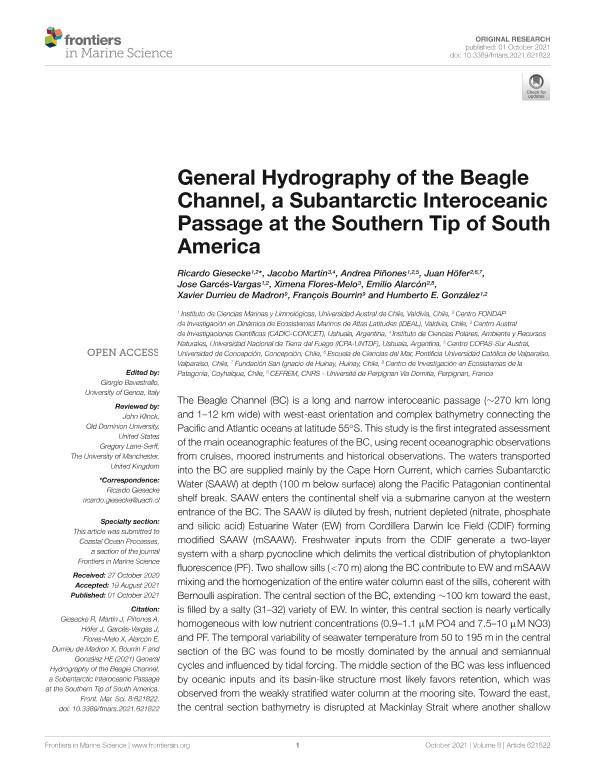Mostrar el registro sencillo del ítem
dc.contributor.author
Giesecke Astorga, Claudio Ricardo

dc.contributor.author
Martín de Nascimento, Jacobo

dc.contributor.author
Piñones, Andrea
dc.contributor.author
Höfer, Juan
dc.contributor.author
Garcés Vargas, Jose
dc.contributor.author
Flores Melo, Elizabeth Ximena

dc.contributor.author
Alarcón, Emilio
dc.contributor.author
Durrieu de Madron, Xavier
dc.contributor.author
Bourrin, François
dc.contributor.author
González, Humberto E.
dc.date.available
2021-12-06T17:18:20Z
dc.date.issued
2021-10
dc.identifier.citation
Giesecke Astorga, Claudio Ricardo; Martín de Nascimento, Jacobo; Piñones, Andrea; Höfer, Juan; Garcés Vargas, Jose; et al.; General Hydrography of the Beagle Channel, a Subantarctic Interoceanic Passage at the Southern Tip of South America; Frontiers Media; Frontiers In Marine Science; 8; 10-2021; 1-21
dc.identifier.issn
2296-7745
dc.identifier.uri
http://hdl.handle.net/11336/148308
dc.description.abstract
The Beagle Channel (BC) is a long and narrow interoceanic passage (∼270 km long and 1–12 km wide) with west-east orientation and complex bathymetry connecting the Pacific and Atlantic oceans at latitude 55°S. This study is the first integrated assessment of the main oceanographic features of the BC, using recent oceanographic observations from cruises, moored instruments and historical observations. The waters transported into the BC are supplied mainly by the Cape Horn Current, which carries Subantarctic Water (SAAW) at depth (100 m below surface) along the Pacific Patagonian continental shelf break. SAAW enters the continental shelf via a submarine canyon at the western entrance of the BC. The SAAW is diluted by fresh, nutrient depleted (nitrate, phosphate and silicic acid) Estuarine Water (EW) from Cordillera Darwin Ice Field (CDIF) forming modified SAAW (mSAAW). Freshwater inputs from the CDIF generate a two-layer system with a sharp pycnocline which delimits the vertical distribution of phytoplankton fluorescence (PF). Two shallow sills (<70 m) along the BC contribute to EW and mSAAW mixing and the homogenization of the entire water column east of the sills, coherent with Bernoulli aspiration. The central section of the BC, extending ∼100 km toward the east, is filled by a salty (31–32) variety of EW. In winter, this central section is nearly vertically homogeneous with low nutrient concentrations (0.9–1.1 μM PO4 and 7.5–10 μM NO3) and PF. The temporal variability of seawater temperature from 50 to 195 m in the central section of the BC was found to be mostly dominated by the annual and semiannual cycles and influenced by tidal forcing. The middle section of the BC was less influenced by oceanic inputs and its basin-like structure most likely favors retention, which was observed from the weakly stratified water column at the mooring site. Toward the east, the central section bathymetry is disrupted at Mackinlay Strait where another shallow sill separates the middle channel from the shallow eastern entrance that connects to the Atlantic Ocean. In this section, a weakly stratified two-layer system is formed when the eastward surface outflow (salty-EW) flows over a deeper, denser tongue of oceanic mSAAW.
dc.format
application/pdf
dc.language.iso
eng
dc.publisher
Frontiers Media

dc.rights
info:eu-repo/semantics/openAccess
dc.rights.uri
https://creativecommons.org/licenses/by/2.5/ar/
dc.subject
BEAGLE CHANNEL
dc.subject
HYDROGRAPHY AND BATHYMETRY
dc.subject
INTEROCEANIC CHANNEL
dc.subject
MICRO-BASINS
dc.subject
SOUTHERN PATAGONIA
dc.subject.classification
Oceanografía, Hidrología, Recursos Hídricos

dc.subject.classification
Ciencias de la Tierra y relacionadas con el Medio Ambiente

dc.subject.classification
CIENCIAS NATURALES Y EXACTAS

dc.title
General Hydrography of the Beagle Channel, a Subantarctic Interoceanic Passage at the Southern Tip of South America
dc.type
info:eu-repo/semantics/article
dc.type
info:ar-repo/semantics/artículo
dc.type
info:eu-repo/semantics/publishedVersion
dc.date.updated
2021-12-03T18:00:23Z
dc.journal.volume
8
dc.journal.pagination
1-21
dc.journal.pais
Estados Unidos

dc.description.fil
Fil: Giesecke Astorga, Claudio Ricardo. Universidad Austral de Chile; Chile
dc.description.fil
Fil: Martín de Nascimento, Jacobo. Consejo Nacional de Investigaciones Científicas y Técnicas. Centro Austral de Investigaciones Científicas; Argentina. Universidad Nacional de Tierra del Fuego, Antártida e Islas del Atlántico Sur. Instituto de Ciencias Polares, Ambientales y Recursos Naturales; Argentina
dc.description.fil
Fil: Piñones, Andrea. Universidad Austral de Chile; Chile
dc.description.fil
Fil: Höfer, Juan. Pontificia Universidad Católica de Valparaíso; Chile
dc.description.fil
Fil: Garcés Vargas, Jose. Universidad Austral de Chile; Chile
dc.description.fil
Fil: Flores Melo, Elizabeth Ximena. Consejo Nacional de Investigaciones Científicas y Técnicas. Centro Austral de Investigaciones Científicas; Argentina
dc.description.fil
Fil: Alarcón, Emilio. Universidad Austral de Chile; Chile
dc.description.fil
Fil: Durrieu de Madron, Xavier. Centre National de la Recherche Scientifique; Francia
dc.description.fil
Fil: Bourrin, François. Centre National de la Recherche Scientifique; Francia
dc.description.fil
Fil: González, Humberto E.. Universidad Austral de Chile; Chile
dc.journal.title
Frontiers In Marine Science

dc.relation.alternativeid
info:eu-repo/semantics/altIdentifier/doi/http://dx.doi.org/10.3389/fmars.2021.621822
dc.relation.alternativeid
info:eu-repo/semantics/altIdentifier/url/https://www.frontiersin.org/articles/10.3389/fmars.2021.621822/full
Archivos asociados
